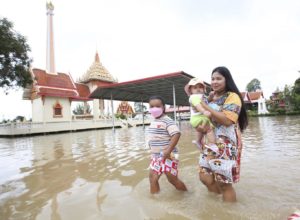As part of the southern region braces for expected seasonal floods, a vast area of the lower North, including Nakhon Sawan, Ang Thong, and Isan remains inundated. Media photos show several houses in flood-hit areas entirely submerged.
A number of people have drowned in floodwaters over the past two months, and yesterday, an ex-member of parliament for Nakhon Sawan died after his car was swept off a road in Nakhon Sawan’s Muang district.
In several provinces, hundreds of residents are still homeless. The Prayut government last week allocated a large budget for relief supplies, but there are complaints about delays and traumatised residents having to depend on their own resourcefulness in order to survive the inundation.
It should also be noted that the focus on humanitarian relief is sometimes to the detriment of water strategy. The Office of National Water Resources (ONWR), which is supposed to serve as an umbrella organisation, is little more than a lame duck.
Sluggish relief and prevention efforts, exacerbated by poor water management, only make the problems worse.
While it’s understandable that some areas are prioritised, the authorities seem to be overly protective of industrial estates and inner-city commercial zones, on the grounds that they are economic hubs.
Yet, what may seem logical to those in power often seems discriminatory to those worst hit, with reports of some residents struggling to cope in unlivable dwellings, like those in Tambon Pa Ngiew, Ang Thong’s Muang district, where demolished flood barriers saw residents left to fend for themselves.
Bangkok has been protected under the same pattern, therefore parts of surrounding provinces, such as Pathum Thani and Nonthaburi, as well as Nakhon Pathom, have to take the burden.
Without a properly coordinated strategy, flooding becomes a cycle, alternating with drought.
Every time severe floods hit, the authorities pledge action, but what plans they make are quickly cast aside as the cycle roles into the dry phase and short-termism prevails once again.
This cannot go on.
It’s time to revamp flood-prevention efforts for whole river basins, and map out water strategies into short- and long-term frameworks.
They have to take into consideration the rising threats of climate change which will require financial measures to ensure that a “flood tax” of sorts can be scooped from the wreckage of these wet summers to pay for more lasting fixes.
With regard to humanitarian relief efforts, the authorities in each flood-hit province must immediately set up relief centres to receive people left homeless, so they will have safe accommodation and food.
And the authorities should also reconsider plans that allow these two extreme climatic factors to help provide solutions to one another. For example, by distributing the floodwater from inundated communities to areas that have been kept dry.
This could help reduce the water level, so as to make the affected communities livable.
There must also be no more unacceptably shoddy work on the part of state authorities.
Action over inaction and giving without expecting to receive are lessons we can take from the most effective efforts yet implemented to alleviate this natural wheel of ill weather fortune.
BANGKOK POST EDITORIAL COLUMN
These editorials represent Bangkok Post thoughts about current issues and situations.
Source: https://www.bangkokpost.com/opinion/opinion/2419998/break-the-flood-cycle



